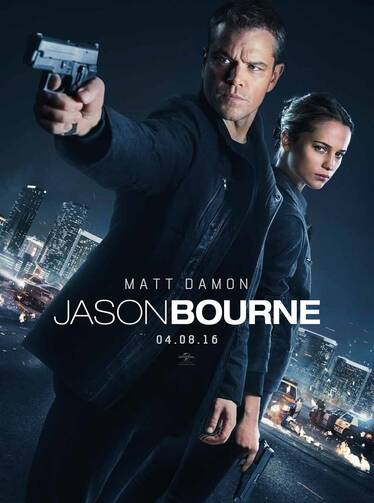This weekend “Jason Bourne,” the newest installment of the Paul Greengrass/Matt Damon Bourne films, drops in theatres worldwide. Like its predecessors, “Jason Bourne” is a masterpiece of hand-to-hand-combat, twisty government conspiracy and action, action, action. (Also, motion blur. Honestly, at this rate the next “Bourne” will be just one long blurry shot with added grunts and gunshots.)
“Bourne” films are like “Law & Order” episodes—when they’re on you can’t help but watch them. Part of that is the bravura filmmaking—from writing to acting to directing to editing, these are great films.
But part of it too is that the films keep things pretty simple. Bourne finds out he’s been lied to. He wants the truth and revenge. Action ensues.
The new film hews closely to that template. But then, surprisingly, one scene near the end threatens to derail the whole escapist exercise. Bourne is chasing bad guy agent Vincent Cassel, known only as “the Asset,” who has been trying to kill him. Bourne has a sports car, the Asset, a SWAT vehicle—basically a slightly sporty tank.
As they fly through downtown Las Vegas, civilian cars get banged up left and right. It’s your typical car chase—that is, until the Asset begins to plow through row upon row of cars stopped in traffic in front of him. It’s a shot that goes on and on, so long in fact that it becomes impossible not to think about the people inside all of those cars. Our action-distracted minds catch up to what’s actually being depicted here—yes, we’re watching a movie car chase, but also a lot of noncombatant “people” are getting injured, probably killed.
From that point on in the sequence, every time a passing car gets hit, the story is eclipsed by this knowledge of the cost. There’s another person dead. And another. And another. In fact, I found my mind starting to drift away from the story entirely, as if I were trying to avoid what had suddenly become downright ghoulish.
Warner Brothers’ “Man of Steel” and “Batman vs. Superman” provoked outrage over director Zack Snyder’s almost pornographic enthusiasm for wiping out massive populated areas without any thought for the cinematic “people” being killed. “Bourne” films don’t generally swim in these sorts of waters (thank goodness), but that car scene begs the same question: What exactly are the ethics of depicting the death of bystanders and innocents in films today?
More specifically: Do filmmakers need only to have narrative concern for “people” who are actually seen beforehand or identified as part of the film plot? Looking at action movies in decades past, that would seem to be the general standard. You have to be careful how you depicted the death of background actors moviegoers could clearly see; but events like plowing through random cars or buildings was fine. Even a gunfight in a crowded plaza was usually okay if you didn’t see anyone in particular get shot.
Today, though, the situation feels different. The Snyder films are definitely at the appalling extreme, but really, in a post 9/11 America (also a post-Columbine, post-Newtown, post-Orlando America), it’s hard to imagine almost any shot of a building collapsing, a bomb going off or a gunfight in a public space that will quickly inspire not only horror, but instinctive revulsion at the underlying loss of life. The ongoing and repeated real-world experiences of such brutalities have stripped away much of the cinematic suspension of disbelief we once were willing to accept in these scenarios. It’s harder and harder for us to fully ignore the faceless and unknown—even as background players in action films.
As a society, we should have great skepticism toward organizations or individuals that maintain blanket condemnations of action films. Usually their so-called concern for “family values” or something equally wholesome conceals an ideological and debatable take on what constitutes goodness, truth or beauty. Like religious leaders of days past, they seek to silence or suppress what they disagree with when they should be engaging with it in the public forum.
But when it comes to depictions of on-screen violence, particularly of the kind described above, it becomes harder not to want to push Hollywood to a greater sensitivity. It may seem ridiculous to demand filmmakers be concerned about minor-to-anonymous or even completely unseen “characters.” But for every faceless person collaterally damaged during a fictional superhero battle or action car chase, there are thousands of real people watching, who may feel all too intimately the loss of life depicted in such sequences.
After the last few months and years of actual violence we’ve endured, for them, for us, it’s rarely “just a movie” anymore.
Jim McDermott, S.J., is America's Los Angeles correspondent.








